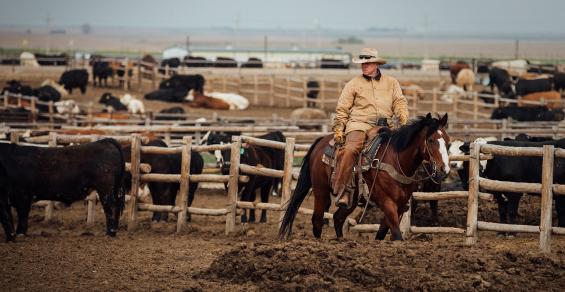From cattle health and well-being to labor management and profitability, there’s a lot keeping producers up at night. One of the most significant concerns of cattle health – Bovine Respiratory Disease (BRD) – is an issue that most producers know all too well.
BRD is a general term for any disease of the upper or lower respiratory tracts, including rhinitis, tracheitis and bronchitis. BRD is most common in recently weaned calves and in feedyard cattle in the first month after arrival. Beef calves that are still nursing may experience BRD as “summer pneumonia.”
Effects of stress on cattle health
There are many factors that may cause cattle to be more susceptible to BRD, but one of the most common is stress, as it can weaken the immune system. These stressors can be environmental, nutritional or management based.
“If the amount of stress placed on calves can be reduced, they are much more likely to stay healthy, productive, and profitable throughout the feeding operation,” says Kevin Hill, D.V.M., technical services veterinarian with Merck Animal Health.
With that in mind, Dr. Hill says producers should work to ensure that all cattle-handling events are planned to maximize animal well-being and comfort, thereby minimizing stress. Well thought out facilities are a tremendous advantage for creating a low-stress environment. When obstacles to movement are removed, cattle flow is always improved. Make sure you show cattle where you want them to go, and then get out of the way. When cattlemen learn to create trust and effectively communicate with their cattle, everything goes more smoothly.
But even with these efforts in place, cattle can still be stressed by normal, everyday occurrences in an operation. These range from weaning and co-mingling to changes in feeding or weather.
“It’s important to evaluate the stress level of cattle that you receive. Abrupt weaning, long hauls, and adverse weather can all add up to high stress and high risk for BRD,” says Dr. Hill. “Stressed cattle can be more difficult to diagnose and, therefore, require more observation time.”
Identifying illness in cattle
Cattle instinctively try to hide illness and injury, which means that the signs of BRD or other illnesses can be difficult to spot.
“A good method for finding sick cattle is to check them immediately after feeding, paying close attention to those that don’t immediately come to the bunk,” says Dr. Hill. “Cattle that are slow to come to feed or water may be in the early stages of respiratory disease.”
Some of the general indicators of illness in cattle include loss of appetite, lethargy or a decreased abdominal fill. Dr. Hill says additional signs of respiratory disease can be nasal discharge, increased respiratory rate, coughing, and fever, as well as runny eyes or drooping ears.
Any animal presenting these signs should be pulled and treated as quickly as possible. Early detection and treatment is the key to complete recovery. To prevent further stress on a sick calf and the rest of the population, the identified animal should be quietly moved to the hospital pen for further evaluation and treatment. Once to the hospital pen, Dr. Hill says a rectal thermometer is essential for the accurate diagnosis of BRD, as cattle suffering from infectious respiratory disease typically have a temperature of 103 to 106 degrees Fahrenheit.
A producer should always follow the written assessment and treatment protocols established by their veterinarian to accurately diagnose and treat health problems. Dr. Hill suggests that producers should never use antibiotics without specific directions from their veterinarian regarding selection of the correct product, using the correct dose and proper route, and observing all withdrawal indications.
“There are many tools available to help treat BRD, so work with your veterinarian to find the best plan to get your cattle back to health as quickly as possible,” he says.
A fast-acting solution
Zuprevo® (tildipirosin) is an effective, injectable antibiotic that puts you in charge of treating and controlling BRD. A fast-acting, long-lasting antibacterial therapy, Zuprevo concentrates in the lungs – the site of infection – to treat BRD.
Zuprevo controls the BRD-causing bacteria that are responsible for the upper and lower respiratory infections that cattle experience. It comes as a convenient, single low-volume dose (1 mL/100 lb) that is easy to calibrate, highly syringeable over a wide range of temperatures and requires only a 21-day withdrawal. A veterinarian can prescribe Zuprevo to treat BRD and to control respiratory disease in cattle at high risk of developing BRD.
“Providing the best care available for your animals is both a good business decision and the right thing to do,” says Dr. Hill. “Zuprevo can be an excellent tool in your operation to help you be successful in the fight against BRD.”
Merck-Animal-Health-usa.com • 800-521-5767
Copyright ©2017 Intervet, Inc., doing business as Merck Animal Health,
a subsidiary of Merck & Co., Inc. All rights reserved.
10/17 BV-56847




Leave A Comment